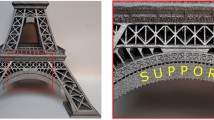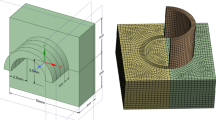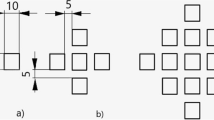Abstract
In this study, a numerical analysis model was developed for analyzing temperature distribution histories, and it was found to perform well based on a comparison of its temperature history results with the temperature history measurements of each layer performed using an IR camera during PBF stacking and the temperature distribution analysis results obtained using vAMpire/Macro®. In addition, the maximum height at which the maximum temperature was reached in each process was predicted through 3D modeling analysis. Furthermore, the temperature distribution histories were analyzed by considering cone supports, regular supports, and wall supports for heat dissipation, and the differences in the heat dissipation effect according to the type and number of supports were quantitatively analyzed. In this manner, it was possible to solve the stacking problem by applying suitable supports, and we suggest that quantitative analysis for solving problems such as stacking failures or thermal deformation is possible through heat transfer analysis.
Similar content being viewed by others
Abbreviations
- ρ :
-
Density
- C p :
-
Specific heat
- q :
-
Heat flux
- k :
-
Thermal conductivity
- h :
-
Convective heat transfer coefficient
- ε :
-
Surface emissivity
- σ :
-
Stefan-Boltzmann constant
References
K. Kempen, B. Vrancken, S. Buls, L. Thijs, J. Van Humbeeck and J. P. Kruth, Selective laser melting of crack-free high density M2 high speed steel parts by baseplate preheating, J. Manuf. Sci. Eng. Trans., 136(6) (2014) 061026.
W. J. Sames, F. A. List, S. Pannala, R. R. Dehoff and S. S. Babu, The metallurgy and processing science of metal additive manufacturing, Int. Mater. Rev., 61(5) (2016) 315–360.
M. Bayat, C. G. Klingaa, S. Mohanty, D. De Baere, J. Thorborg, N. S. Tiedje and J. H. Hattel, Part-scale thermo-mechanical modelling of distortions in laser powder bed fusion - analysis of the sequential flash heating method with experimental validation, Addit. Manuf., 36 (2020) 101508.
A. Aliyev, K.-K. Lee and D.-G. Ahn, Effects of deposition strategies on thermo-mechanical characteristics of inconel 718 deposited region on AISI 1045 substrate with a cantilever structure by LENS process, Journal of Mechanical Science and Technology, 36 (2022) 4695–4705.
J. H. Bae, J. M. Yu, V. H. Dao, V. Lok and K. B. Yoon, Effects of processing parameters on creep behavior of 316L stainless steel produced using selective laser melting, Journal of Mechanical Science and Technology, 35 (2021) 3803–3812.
Y. Yang, Y. Gong, S. Qu, B. Xin, Y. Xu and Y. Qi, Additive/subtractive hybrid manufacturing of 316L stainless steel powder: densification, microhardness and residual stress, Journal of Mechanical Science and Technology, 33 (2019) 5797–5807.
P. Alvarez, J. Ecenarro, I. Setien and M. San Sebastian, Alberto echeverria and luka eciolaza, computationally efficient distortion prediction in powder bed fusion additive manufacturing, International Journal of Engineering Research and Science, 10 (2016) 39–46.
X. Liang, L. Cheng, Q. Chen, Q. Yang and A. C. To, A modified method for estimating inherent strains from detailed process simulation for fast residual distortion prediction of single-walled structures fabricated by directed energy deposition, Addit. Manuf., 23 (2018) 471–486.
L. A. Parry, I. A. Ashcroft and R. D. Wildman, Geometrical effects on residual stress in selective laser melting, Addit. Manu., 25 (2019) 166–175.
T. Mukherjee, W. Zhang and T. DebRoy, An improved prediction of residual stresses and distortion in additive manufacturing, Comput. Mater. Sci., 126 (2017) 360–372.
B. Cheng, S. Shrestha and K. Chou, Stress and deformation evaluations of scanning strategy effect in selective laser melting, Addit. Manuf., 12 (2016) 240–251.
G. Vastola, G. Zhang, Q. X. Pei and Y. W. Zhang, Controlling of residual stress in additive manufacturing of Ti6Al4V by finite element modeling, Addit. Manuf., 12 (2016) 231–239.
P. Bian, X. Shao and J. Du, Finite element analysis of thermal stress and thermal deformation in typical part during SLM, Appl. Sci., 9(11) (2019) 2331.
A. J. Dunbar, E. R. Denlinger, M. F. Gouge and P. Michaleris, Experimental validation of finite element modeling for laser powder bed fusion deformation, Addit. Manuf., 12 (2016) 108–120.
G. Strano, L. Hao, R. Everson and K. Evans, A new approach to the design and optimization of support structures in additive manufacturing, International Journal of Advanced Manufacturing Technology, 66(9–12) (2013) 1247–1254.
Author information
Authors and Affiliations
Corresponding author
Additional information
Seok-Chul Yun received his B.Sc. degree from Yeungnam University, Korea, in 2007. He received his M.Sc. degree in Mechanical Engineering from Yeungnam University, Korea, in 2009. His research interests include welding process optimization, additive manufacturing process.
Kyunsuk Choi received his B.Sc. and M.Sc. degrees, in Metallurgical Engineering from Inha University, in 2001 and 2003, respectively. He received his Ph.D. degrees in Materials Science and Engineering from Yonsei University, Korea, in 2017. He is currently a Professor at the Department of Industry-University Convergence, Hanbat National University, Korea. His research interests include metallic additive manufacturing materials, digital twin and autonomous systems.
Jae-Woong Kim received his B.Sc. degree from Ajou University, Korea, in 1982. He received his M.Sc. and Ph.D. degrees, in Mech. and Production Eng. from Korea Advanced Institute of Science and Technology, in 1984 and 1991, respectively. He is currently a Professor at the School of Mechanical Eng., Yeungnam University, Korea. His research interests include analyses of welding and additive manufacturing process, thermal stress and distortion.
Rights and permissions
About this article
Cite this article
Yun, SC., Choi, K. & Kim, JW. A study on the effect of shape and number of supports in additive manufacturing process by using a macro heat transfer analysis. J Mech Sci Technol 38, 851–860 (2024). https://doi.org/10.1007/s12206-024-0132-y
Received:
Revised:
Accepted:
Published:
Issue Date:
DOI: https://doi.org/10.1007/s12206-024-0132-y




